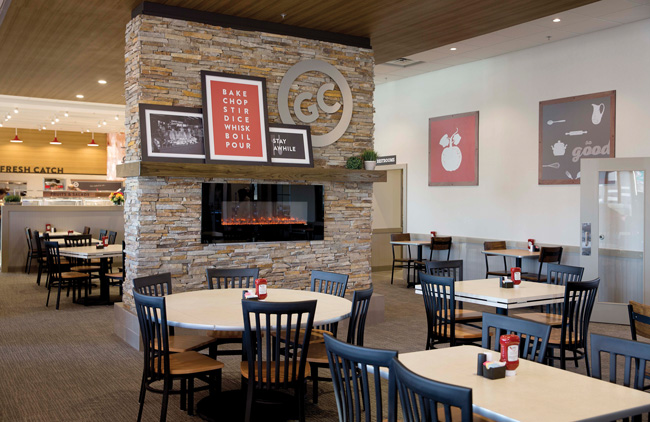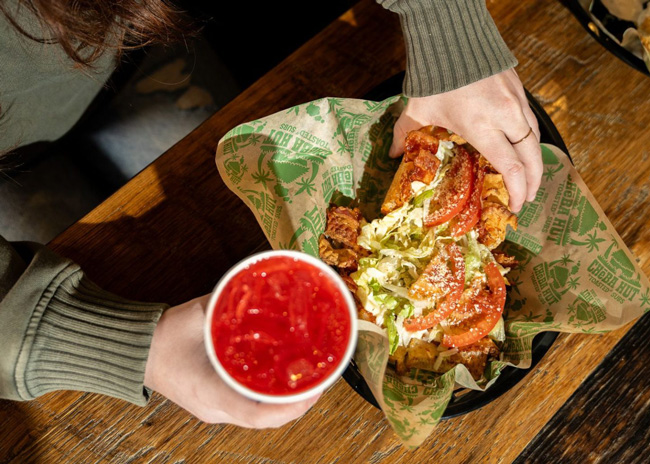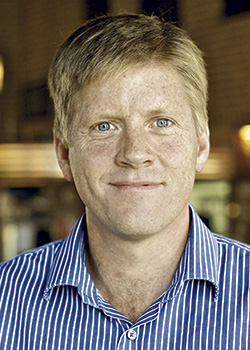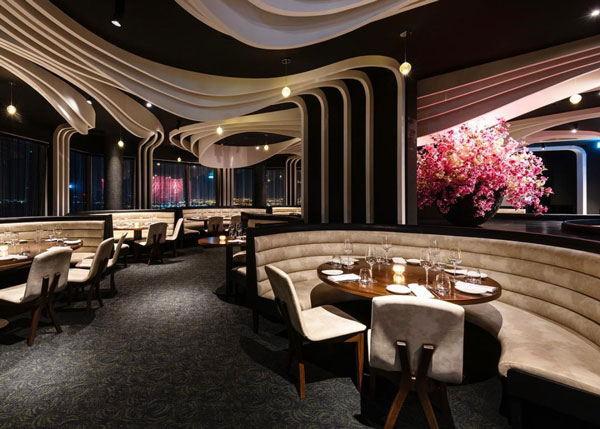The restaurant industry is changing, and Golden Corral is changing along with it.
In December 2017, this 47-year-old family-dining stalwart rolled out a new prototype in Greensborough, N.C., in response to two big industry trends, says the chain’s Senior Vice President of Development David Conklin.
First, competitors have raised the bar in facility design, and guest expectations for restaurant design have risen to match. Second, increasing labor costs have squeezed the chain’s margins, exposing inefficiencies in its previous setup. “As we looked to the future of the brand, we wanted to make sure we had the right vehicle for growth, one that would really drive the guest experience and provide the operational efficiency,” Conklin says.
Though these are big goals for any redesign, this project, stresses Conklin, isn’t part of a move away from Golden Corral’s roots. The chain is still a family-friendly buffet, just with a different expression.
 A working fireplace is the centerpiece of the new, residential-style interior design. Images courtesy of Golden Corral
A working fireplace is the centerpiece of the new, residential-style interior design. Images courtesy of Golden Corral
Deliberate Development
According to Aaron Ruef, director in the specialty retail group at FRCH Design Worldwide, the project’s interior designer, the chain’s new prototype is inspired by residential expressions of hospitality: “an invitation for the guest to indulge, relax and share in the bounty that is Golden Corral and the choices that they offer.”
While this approach is fitting for a family-style-buffet restaurant, Golden Corral didn’t just go with its gut in selecting it. Instead, the chain took a methodical approach to addressing its needs along with the concerns of key stakeholders.
The effort started with the creation of a prototype design team. This group included not just the chain’s leadership but carefully selected franchisees as well.
“These were all operators,” says Conklin. “It wasn’t just business owners, so to speak. It was business owners who’d been in the system for a considerably long period of time. They really had an opportunity to weigh in and provide their feedback on things that would work not only from an operational standpoint but in terms of how they viewed the business. It gave us a 360-degree view of this whole project.”
With this insight, the franchisees and senior leadership started by interviewing external design talent, eventually choosing Profitality for kitchen/operational design and FRCH for the interior. After selecting the design team, Golden Corral had representatives from both firms visit its restaurants to get a better feel for the concept and the people it serves. Since Golden Corral set out to enhance the customer experience and not fundamentally change the brand, this was an important step in the process, Conklin says.
While this step focused primarily on culture and environment, the next phase dealt more with operations. The designers conducted time/motion studies of Golden Corral locations, educating the leadership team, says Conklin, in “how customers move, how our employees move. They counted steps. They went through every position and really got a comprehensive look at the business.”
 The new design includes multiple seating areas and dividers, providing guests with seating options and breaking up the space into warmer, friendlier zones.
The new design includes multiple seating areas and dividers, providing guests with seating options and breaking up the space into warmer, friendlier zones.
Combined, these two phases of the project gave FRCH a starting point and direction for the new prototype’s look and feel. The firm went on to develop three different design concepts, which were then reviewed by customer and research groups. The groups gave positive scores to some elements found in all the designs, including more natural lighting, modern decor, open spaces and sophisticated exteriors, while raising concerns about anything that felt loud, uncomfortable or overcrowded.
Instead of settling on a single look, the prototype team took the best of all three designs, leading to the creation of a fourth and final concept.
With drawings in hand, most restaurant chains move on to building that first store. Golden Corral, however, took an extra step, described by Conklin as “the number one best thing that we did.”
The chain found a large warehouse space where it created a full-scale layout of the new design’s interior dimensions. Using cardboard and wood, Golden Corral built full-sized mockups of its new buffet line and island buffet bars and even created the layout for kitchen equipment. For the dining area, Golden Corral brought in real tables and chairs. The prototype team then walked through the space, experienced how traffic would actually flow and feel, and made adjustments as needed.
“We literally picked up the wood and cardboard bar, slid it over a foot and said, ‘How does that feel?’ We had the architect there, and they’d take a new measurement. That is how we ended up where we are now,” Conklin says.
A number of adjustments came out of this exercise. Not only did the positioning of the island bars change, but it allowed the chain to better respond to customer requests for a roomier environment: More space was added to aisles and between tables, while the tables themselves got bigger.
Of course, there was some push and pull during and after the exercise. Changing the dining area to give guests more space cost some seats and forced the kitchen to shrink. The chain was able to partially offset these losses, though, through the kitchen redesign and its focus on efficient movement, Conklin says.
Overall, this process wasn’t too costly or time-consuming, Conklin notes. Golden Corral had in-house teams make the model bars and equipment. Setting up the space took about a week, while the prototype team performed its walk-through in a single afternoon.
The exercise allowed Golden Corral to build a better, more functional restaurant with its very first store, limiting the number of changes it plans to make to future stores. “If we had to move the bar three feet this way or two feet that way after we had built it, it would have been extremely difficult and expensive to do,” says Conklin. “We attribute a lot of where we landed and how happy we are with where we landed to that process. Cardboard and paper and wood is a lot easier to move around than the real thing after it’s built.”
 The chain’s new buffet includes island bars, allowing guests to browse their options more easily than the straight line used previously.
The chain’s new buffet includes island bars, allowing guests to browse their options more easily than the straight line used previously.
Homey but Efficient
The real-world efficiencies of the new restaurant can be seen not just in the buffet and kitchen but in the dining room as well. According to Ruef, the space is designed to be easy to service. This is achieved partly through the use of seating zones. The area, he said, is designed to be filled by guests from right to left, with the zone on the far left serving as a private dining space if needed. By subtly encouraging guests to sit in specific areas, the chain can limit the number of steps staff need to bus tables and refill glasses.
Another key efficiency in the dining room is achieved through the creation of a new server station. Located in the middle of the dining area but shielded with millwork, this station is used to store silverware, the soda fountain, and trays and carts for bussing tables. “It’s basically a concealed area for the staff to be able to clear tables and not have to go all the way back to the kitchen if they’re in the back of the dining room,” says Ruef.
Efficiency, of course, is only one of the goals of this new prototype. Creating a more welcoming environment is another.
Golden Corral’s new residential feel starts from the outside. While the previous design emphasized the brand’s signature red, the new prototype brings in more natural tones and elements that impart a feeling of warmth.
One of the exterior’s key features, for instance, is a stacked stone tower that adds a sophisticated element. Highlighted by a yellow LED strip, it also serves as an ideal spot for the chain’s signage.
The new exterior includes a wooden trellis, which breaks up the building, making it warmer and less boxy, says Conklin. Branded elements include a large painted Golden Corral stamp-style logo and a red awning above residential-style windows. These windows give the space an open and inviting feel from the outside — almost glowing at night, Conklin says — while providing plenty of natural light.
When guests enter the restaurant, the Golden Corral customer journey has them join the POS line. While this leads to a transaction, the new design makes it feel less transactional than before. The lighting in this space was warmed up, for example, and residential-style touches were added to the space, such as millwork guides (instead of metal) for the queue.
The chain also removed its self-serve beverage machine, adopting a model where servers provide beverages and refills. In addition to offering guests a higher level of service, says Conklin, this change has eliminated visual clutter at the entry and sped up the POS line.
The overall layout of the entry and POS system has also changed to provide a more limited view of the restaurant itself, says Ruef. After paying, he says, “You walk into the space, and there’s this release or unveiling of the warmth and invitation of the buffet and the seating area.”
 Guest seating includes a room that can be closed off to serve as a private dining room.
Guest seating includes a room that can be closed off to serve as a private dining room.
When they enter the restaurant, longtime guests will notice another major layout change: the location of the kitchen and adjacent buffet line. Golden Corral’s previous design placed these on a side wall, running the entire length of the restaurant. This approach presented some challenges for the customer. Expecting guests to walk the entire length of the restaurant to see their options is a big ask, Conklin says. In addition, the layout exposed many seats to the noise and commotion of the line and kitchen — a direct collision with the goal of creating a more open, relaxed environment.
In the redesigned space, the kitchen/buffet has been moved to a corner of the restaurant; instead of a straight line, it is L-shaped, with three island bars sitting in the middle of the area. Locating the buffet in this more concentrated space allows guests to wander a bit and see all their options while also limiting the number of nearby seats impacted by the activity.
The space was also calmed by changes made to the kitchen. While the previous design had the kitchen wide open, now much of it sits behind a wall. Customers are given curated views into just a few select spaces, such as the grill, carving station and cake-decorating station, allowing the chain to highlight the work it puts into its food while keeping the messier, noisier aspects of a professional kitchen hidden.
The overall look and feel of the kitchen/ buffet has changed as well, going from an industrial feel to a more residential design. The islands are wooden with paint and laminate, while the tops are a bright solid surface. The stations along the line have tiled back walls and overhead wall coverings with a wooden look.
Once guests have their food, they move into the dining area, where they have plenty of choices for seating, including booths with vinyl upholstery and laminate four-, six- and eight-tops. In addition, the seats are broken up with various dividers, helping create more intimate zones in a large space.
The decor in the dining area includes artwork that stresses food quality and the effort that Golden Corral puts into its cooking as well as small plants that someone might have on a kitchen windowsill.
The new prototype hits the residential theme head-on with the new dining room’s centerpiece: a two-sided gas-fired fireplace. This piece is clad in stone and includes a mantle where the chain places small branded art pieces and a few small manageable potted plants.
The fireplace, says Conklin, has proven popular with guests, and nearby seats are typically the first to fill up. “Few things are as inviting as a fire — the idea of gathering around the hearth,” he says.
Minimal Adjustments, Value Engineering
With the new prototype in operation for just a few months, the chain is still kicking the tires on the new design, Conklin says. So far, though, Golden Corral has only found a few adjustments that need to be made thanks to the exercise with the full-scale model.
The company is in the value engineering phase of the project, looking for roughly equivalent materials and finishes (such as a panelized faux stacked stone for the exterior tower) to lower build costs.
Overall, though, the chain is pleased with the new look. More important, customers are responding well, especially at the first prototype location. Their response, the chain hopes, will be echoed as more new stores are rolled out, according to Conklin. “Guests walk into this restaurant, and they just stop,” he says. “This was a teardown replacement. The customers were used to the old design. To see them walk through the door and be in awe — it’s just fun.”
Project Team
- Project lead: David Conklin, Golden Corral
- Architect: Ray Thornton, National Restaurant Design
- Kitchen supplier: Coastal Equipment
- Interior design: Aaron Ruef, FRCH Design
- Kitchen design: Juan Martinez, Profitality
- The chain’s new buffet includes island bars, allowing guests to browse their options more easily than the straight line used previously.
- Golden Corral Feels Like Home
- Guest seating includes a room that can be closed off to serve as a private dining room.
Snapshot
- Headquarters: 5151 Glenwood Ave., Raleigh, N.C.
- Concept owner: Privately owned
- Concept: Family buffet
- Segment: Family dining/midscale
- Location: National brand with locations in 41 states
- Units: 489
- Opened: 20 units in 2017
- Size: Approximately 10,000 square feet
- Real estate: Freestanding, in-line, endcap
- Design highlights: Exterior: oversized windows, stacked stone towers, red awnings and a wood trellis. Interior: warm, homey feeling; hearth and home environment. More spacious seating, quieter dining room, fireplace, wood-tone ceilings, oversized windows. More efficient kitchen layout and food bar design.
- Build-out time: 120-150 days



